Ascii Art of Bean Simple Ascii Art of Bean

We all use text-based fields at once or some other, and being limited to ASCII simply can stop upwards existence a limitation. That'southward what led [Luke Wren] to create asciiwave, a fantastic tool that turns WaveDrom timing diagrams into ASCII art. Different images, ASCII timing diagrams are suitable for pasting into comment fields, change logs, or anywhere else that accepts text only. [Update: As the author kindly shared in the comments below, this tool's original niche is pasting into HDL (east.g. Verilog) source lawmaking comments, where it has a special kind of usefulness.]
WaveDrom itself is a bully JavaScript tool that we have covered before. Information technology accepts timing diagrams expressed every bit JSON data, and renders nicely-readable digital timing diagrams as images directly inside one's browser.
Equally cool and useful equally that is, images can't be pasted into text fields. That'due south where asciiwave comes in. It reads the exact aforementioned format that WaveDrom uses, but generates an ASCII-art timing diagram instead. So if you've found WaveDrom useful, but wish you could generate ASCII versions, hither's your solution.
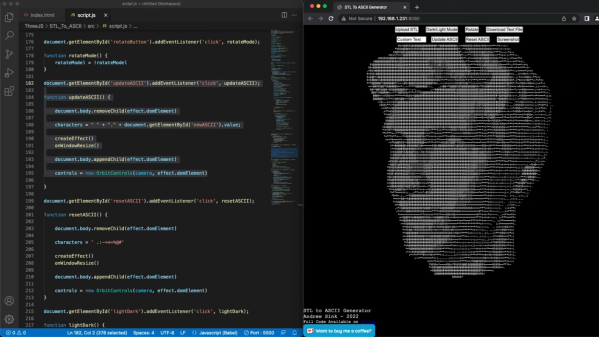
If y'all look difficult enough, most of the projects we feature on these pages have some practical value. They may seem frivolous, but there's usually something that compelled the hacker to commit time and effort to its doing. That doesn't hateful nosotros don't become our share of just-for-funsies projects, of course, which certainly describes this online 3D ASCII art generator.
Simply wait — maybe that's not quite right. Afterwards all, [Andrew Sink] put a lot of time into the code for this, and for its predecessor, his automated 3D low-poly generator. That projection led to the current work, which similar earlier takes an STL model equally input, this time turning it into an ASCII art render. The character set used for shading the model is customizable; with the default set, the shading is surprisingly skilful, though. You lot tin can besides swap to a black-on-white theme if you lot like, navigate around the model with the mouse, and fifty-fifty export the ASCII art as either a PNG or as a raw text file, no doubt suitable to send to your tractor-feed printer.
[Andrew]'s code, which is all up on GitHub, makes liberal utilize of the 3.js library, so maybe stretching his 3D JavaScript skills is really the hidden practical aspect of this 1. Not that information technology needs one — we think it'due south absurd just for the gee-whiz factor.
Continue reading "Online Tool Turns STLs Into 3D ASCII Art"
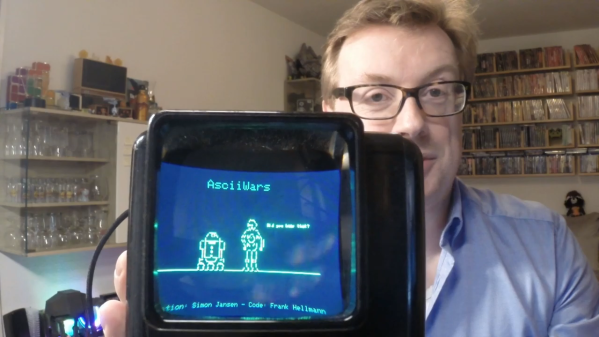
Everyone by at present has probably seen the original — and best; fight the states — installment of the Star Wars franchise, and probable the ASCII-art blitheness version of information technology that improves greatly on the motion picture by eliminating all those distracting special furnishings, man actors, and the soundtrack. Only what we oasis't had until now is a portable player for ASCIIWars, to relish the film in all its character-based glory while yous're on the go.
While this tribute to [Simon Jansen]'due south astonishing ASCII-art achievement might seem like a elementary repackaging of the original, [Frank] actually had to become to some lengths to brand this work. Later getting [Simon]'s approval, the build started with a WEMOS D1 Mini, a good platform for the project less for its wireless capabilities and more for its iv MB of flash memory. A 240×360 TFT LCD display was selected to evidence the film; the scale of the brandish made most fonts hard to read, so [Frank] used Picopixel, a font designed for legibility on small screens. The animation file is stored on the SPIFFS file system on the D1's flash memory, and a few lines of code parse it and send information technology to the brandish. The final affect is mounting the whole thing is an sometime slide viewer, which magnifies the brandish to brand it a niggling easier to see.
As much as we applaud [Frank]'s tribute to [Simon]'s effort, there's no reason to confine this to the Star Wars universe. If yous read upwardly on the history of ASCII art, which goes surprisingly far dorsum, y'all might be inspired to render another classic movie in ASCIImation and put it on a viewer like this. ASCII-City, anyone?
Go along reading "Savor An ASCII Version Of Star Wars In The Palm Of Your Manus For May The 4th"
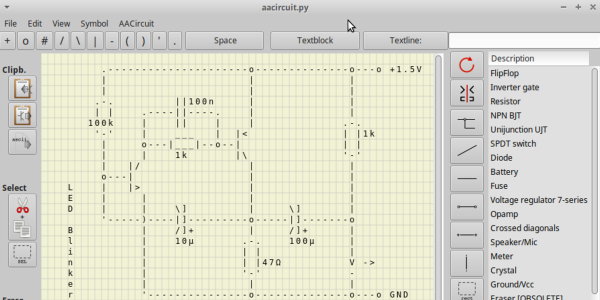
We wondered recently about those crude ASCII schematics you see in some documentation — are there any dedicated schematic-focused tools to draw them, or are they merely mitt-crafted using various ASCII-fine art drawing tools? To our surprise, there is such a tool. It is called AACircuit and was developed by [Andreas Weber]. It has a history going back to 2001 when it was kickoff introduced as ASCIIPaint. Be forewarned, nonetheless, the quality of the lawmaking may be questionable. According to the notes on [Andy]'s GitHub repository:
WARNING: a lot of spaghetti code alee
This code was created in 2001-2004 when I taught Borland Delphi 3 to myself. Information technology contains many, many global variables, unstructured and undocumented procedural code and bad variable names.
" data-image-caption="" data-medium-file="https://hackaday.com/wp-content/uploads/2021/04/aacircuit-duckman-arduino-uno-pinout-1.png?w=355" data-large-file="https://hackaday.com/wp-content/uploads/2021/04/aacircuit-duckman-arduino-uno-pinout-1.png?w=473" class="alignleft wp-image-474162 size-medium" src="https://hackaday.com/wp-content/uploads/2021/04/aacircuit-duckman-arduino-uno-pinout-1.png?w=355" alt="" width="355" height="400" srcset="https://hackaday.com/wp-content/uploads/2021/04/aacircuit-duckman-arduino-uno-pinout-1.png 473w, https://hackaday.com/wp-content/uploads/2021/04/aacircuit-duckman-arduino-uno-pinout-1.png?resize=222,250 222w, https://hackaday.com/wp-content/uploads/2021/04/aacircuit-duckman-arduino-uno-pinout-1.png?resize=355,400 355w" sizes="(max-width: 355px) 100vw, 355px">
If you lot don't want to wrestle with onetime and sketchy object-oriented Pascal code, yous're in luck. [Chaos Ordered] has made a Pythonized version which you tin can get from his GitHub repository. We tried it out and got information technology working on Ubuntu in curt order (after wrestling with a pycairo dependencies). This might not be everyone'due south cup of tea, but it has some uses now and and so. While we wouldn't want to document a computer motherboard with ASCII schematics, information technology'southward great for a quick-and-dirty circuit diagrams.
Not exactly schematics, but [Duckman] has some Arduino pinout diagrams he made using ASCII-fine art. These could be useful when pasted into source code as comments, documenting the pinouts for your project.
Practise y'all recommend any tools for making ASCII schematics, or this but a waste of time?
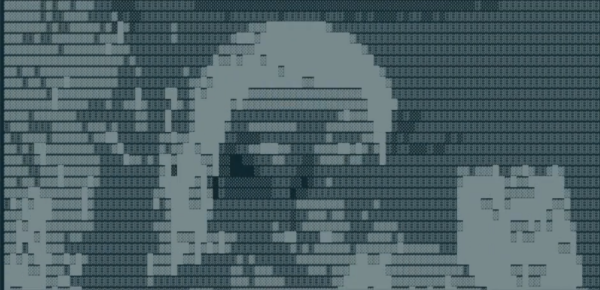
At some point or another, many of us have tried to see how much of our digital lives could exist accessed from the condolement of a terminal. Nosotros've tried Alpine for email, W3M for spider web browsing, and fifty-fifty watched Star Wars via telnet. But, in the increasingly socially-distant world we observe ourselves in today, we detect ourselves request: what about video calling?
Okay, we weren't asking that. But thankfully [Andy Kong] was, and saw fit to implement it when he and a friend created AsciiZOOM, a "secure, text-based videoconferencing app, attainable from the safety of your last."
As you may take guessed, [Andy]'s solution replaces the conventional video stream nosotros're all used to with realtime animated ASCII art. The system works past capturing a video stream from a webcam, "compressing" each pixel by converting it into an ASCII graphic symbol, and stuffing the entire frame into a TCP package. Each client is connected to a server (meeting room?) which coordinates the packets, sending them back and forth appropriately.
Equally impressive as information technology is impractical, the simply surface area in which the projection lacks is in audio. [Andy] suggests using Discord to solve that, but here'due south hoping we see subtitles in version 2! Volition AsciiZOOM be replacing our favorite videoconferencing suite any time before long? No. Are we glad it exists? You betcha.
Continue reading "Real Hackers Videoconference In Terminal"

In instance you grow tired of clear-written, understandable lawmaking, obfuscation contests provide a nice change of scenery, and trying to make sense of their entries tin can be a fun-fourth dimension activeness and an interesting culling to the usual brainteasers. If we ever happen to run into a Simpsons episode on the subject, [Andy Sloane] has the obvious candidate for a [Hackerman Homer] entry: a rotating ASCII art donut, formatted equally donut-shaped C code.
The code itself actually dates back to 2006, merely has recently resurfaced on Reddit after [Lex Fridman] posted a video near it on YouTube, then we figured nosotros take that chance to give some further attention to this cracking piece of art. [Andy]'south blog article goes in all the details of the rotation math, and how he simply uses ASCII characters with different pixel amounts to emulate the illumination. For those who adopt C over mathematical notation, nosotros added a reformatted version after the suspension.
Sure, the code's donut shape is mainly owed to the added filler comments, but allow's face it, the donut shape is just a bully little addition, and the lawmaking wouldn't be whatever less impressive squeezed all in one line — or multiple lines of appropriate lengths. However, for the bodily 2006 IOCCC, [Andy] took it a serious step further with his entry, and you should definitely give that one a try. For some more obfuscated shell animations, check out the fluid dynamics simulator from a few years back, and for a more recent entry, have a look at the printf Tic Tac Toe we covered last month.
Go on reading "Mmm… Obfuscated Crush Donuts"
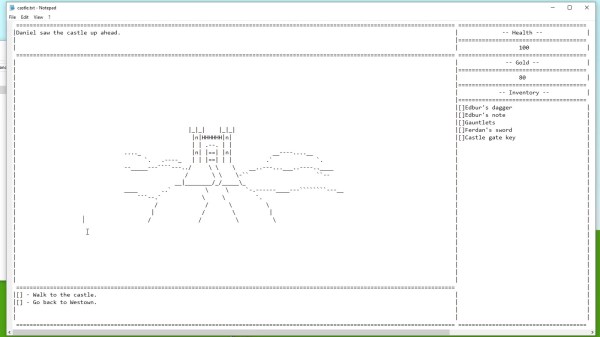
We all have our favorite text editor, and are willing to defend its superiority higher up all other editors by any ways necessary. And then at that place's Notepad. Merely what Notepad may lack in text manipulation features, it compensates with its camouflaged qualities as a gaming platform. Yes, you read that correctly, and [Sheepolution] delivers the proof with a text-based adventure game running within Notepad.
What started out with [Sheepolution] jokingly wondering what such a game may expect like, ended up equally an bodily implementation as answer to it. Behind the scenes, a script written in Lua using the LÖVE framework — for which he besides created an all-encompassing tutorial — monitors the land of several text files that make up the game earth. Each location is a separate text file to open in Notepad, showing the current land of the game, telling the story with text and ASCII art, and offering choices to the thespian. The game is played by modifying and saving those text files, which the script then processes to push the gameplay forrad past simply updating the content of those files with the new land. Cheque out the game'due south trailer after the suspension to get a feel of what that looks like.
Unfortunately, Notepad itself doesn't automatically reload the file when its content changes, so to provide a smoother gaming experience, [Sheepolution] modified the open source implementation Notepad2 to work around this, and arranged it as role of the game's executable. Initially, he fifty-fifty added animations to the ASCII graphics, only in the finish decided against most of them to avoid constant disk writes and race weather caused by them.
Sure, this is no Game Boy emulator in a text editor, and information technology may not be as groundbreaking every bit Notepad's latest characteristic, but it's e'er amusing to see alternative uses for well-established tools.
Continue reading "Slaying Dragons In Notepad"
Source: https://hackaday.com/tag/ascii-art/
0 Response to "Ascii Art of Bean Simple Ascii Art of Bean"
Post a Comment